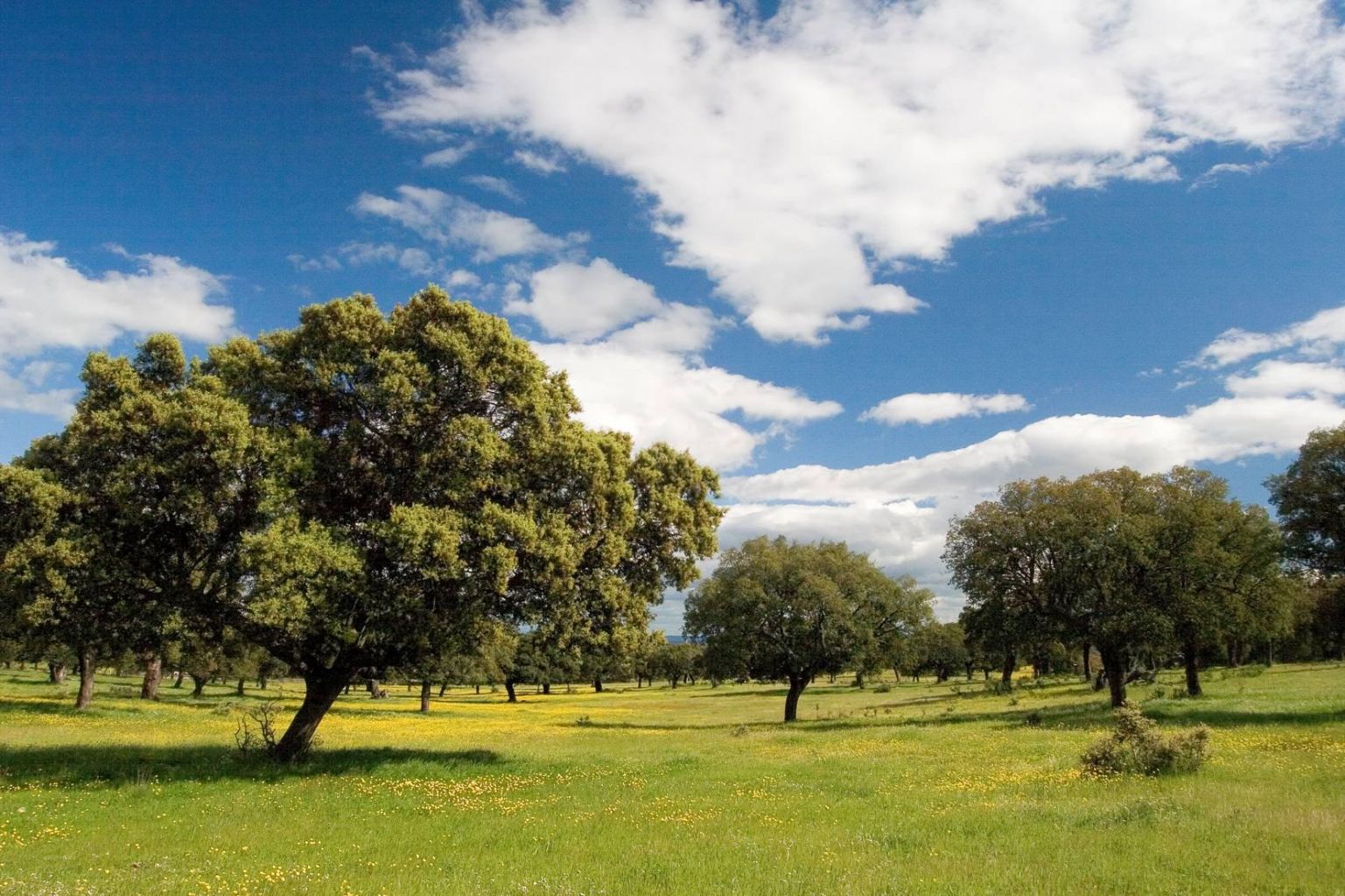
Le système Dehesa en Espagne
Description du système
Dehesa est un système silvopastoral formé du nettoyage de régions boisées à feuilles persistantes où les arbres, les zones herbacées natives, la récolte et le bétail interagissent. À présent, dehesas occupe 2.3 millions d'hectares en Espagne et 0.7 millions d'hectares au Portugal, où ils sont appelés "montados". Les Dehesas résultent d'une simplification, dans la structure et richesse des espèces, des forêts méditerranéennes et garrigues. Elles réduisent la densité d'arbre, éliminant l'arbuste et favorisant la couche d'herbe au moyen du pâturage et de la culture. Les Dehesas sont caractérisées par des races de bétail traditionnelles à faible densité d'approvisionnement et par l'exploitation de chênes à feuilles persistantes.
Les Dehesas sont parmi les meilleurs systèmes d'agriculture de basse intensité préservés en Europe et sont considèrés comme une exemplaire gestion des terres par l'utilisation de terre traditionnelle et par la conservation de biodiversité.
Réunion initiales des partenaires
La première réunion du groupe a eu lieu le 30 mai 2014 à l'École de Sylviculture de l'Université d'Extremadura dans Plasencia. La réunion initiale a été très bien suivie avec plus de 90 partenaires présents. Les participants étaient des fermiers, des éleveurs, des forestiers, des propriétaires terriens, des représentants d'associations régionales et nationales, des entreprises de services agricoles, des services d'extension, des ONG concernant la nature, des groupes d'action locaux et des décideurs.
Une analyse complète de la perception des aspects positifs et négatifs du système dehesa et des innovations potentielles pour la recherche a été entreprise. Des domaines potentiels identifiés pour la recherche étaient des méthodes pour la régénération de l'arbre, la récolte du fourrage, le pâturage et la possibilité d'une marque déposée de dehesa.
Si vous souhaitez connaître l'activité de ce groupe, contactez Dr. Gerardo Moreno à l'université de Extremadura.
Télécharger le rapport
Download the initial research and development protocol
Download the system description
A research update on dehesas in Spain was produced in December 2015.
Lessons learnt
Gerardo Moreno and colleagues at the University of Extremadura have written a comprehensive and informative report on the various innovations tested within the Dehesa stakeholder group in Spain.
The first part of the report focus on the search of alternative low cost shelters and practices for the regeneration of the trees of the dehesa. Some of the main lessons learnt are:
- Tree regeneration in the dehesa needs to be an integrated part of regular management practice; a rotational stage of grazing exclusion could be included in long-term farm management plans.
- Assisted regeneration can be based either on seeding acorns or on planting nursery-grown seedlings. Both approaches require seed and/or seedling protection.
- Application of cat/dog excrement around sown acorns can be recommended for small scale reforestation. CHANGE around young plants BY acorns sown
- Thorny wire-mesh tree guards proved to be an efficient, long-lasting solution and cheaper form of tree protection than classic wire mesh tree guards.
The second part of the report focuses on the option to improve fodder self-sufficiency by using protein-rich fodder crops and self-seeding pastures. Some of the main lessons learnt are:
- Three varieties of triticale are recommended; the trees can increase winter forage yields and the quality of the forage. The triticale can be grazed by livestock in the winter before the start of stem elongation.
- The sowing of legume-rich self-reseeding pasture can increase pasture productivity and quality for at least a decade. Grazing needs to be delayed in the initial years to ensure good establishment.
- The increase in the soil nitrogen, due to the legumes, also increases the protein content of other pasture species.
- The sowing of pasture increased the soil content of carbon accumulated. Although it reduced slightly the α diversity of plants, the total species richness (ϒ diversity) was unaltered.
- Farmers in the study reported that the improvement in the pasture quality and productivity offset the costs of the seed mixture and fertilizers.
The third part of the report focused on consumer acceptance for dehesa products and services. Some of the lessons learnt are:
- Consumers were more familiar with the term "dehesa" than "agroforestry"
- Consumers associated the dehesa with high-quality livestock products and a landscape of high cultural value.
- Possible dehesa products with development potential include asparagus, fungi and mushrooms, acorn-based foods, medicinal plants and cosmetics, herbs and herbal tea. CHANGE acorn beer BY acorn-based foods
Lastly the report highlights that more research is still needed on the use of new technologies (such as GPS collars) to improve dehesa management and the use of fast-intensive rotational management. Preliminary results also indicate that (ignoring the methane produced by livestock), a positive annual carbon balance of the dehesa of Majadas of about 0.5 t C/ha.